In NOLA there is no dearth of signs like this:
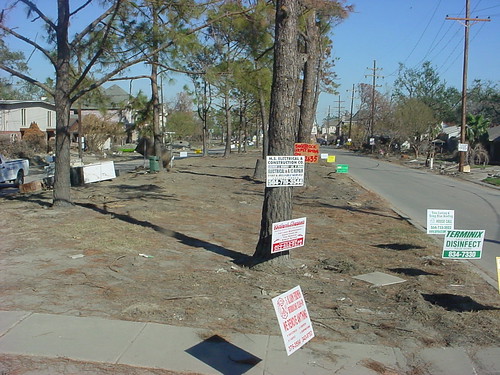
popping up all over street corners and other high-visibility sites, advertising jobs, loans, cleaning and restoration services, "house gutting", and often just that businesses closed for storm damage have re-opened again. Among these are always the ones announcing "Katrina lawsuits" and legal assistance.
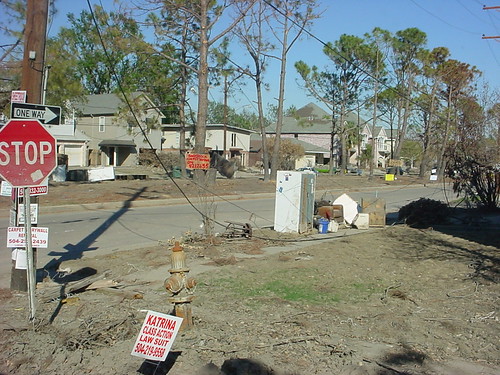
Why?
In
yesterday's NYTimes, the editorial noticed that Katrina survivors, having had enough of Bush's compassionate conservatism, are taking matters into their own hands:
"Public outrage is clearly growing over the federal government's woefully inadequate program for housing the hundreds of thousands of people displaced by Hurricane Katrina. Last week a group of survivors filed the first of what are likely to be several lawsuits alleging that the Federal Emergency Management Agency has failed to live up to its responsibilities. The recovery effort has been subject to blistering criticism from conservative, nonpartisan and liberal groups alike.
The same basic question is this: Why did the Bush administration focus on trailer parks built by FEMA - which is actually not a housing agency - instead of giving the lead role to the Department of Housing and Urban Development, which has so much experience on this issue?"
"Outrage" barely expresses it. Everywhere you go in New Orleans and environs you can see the anger, written on the sides of buildings (
"Screw you, Nagin, we made our own plan"), spelled out on broken signs with magnetic letters (
"Where was FEMA?"), scrawled on the ruined appliances that litter the streets ("
Build a crap wall. What Katrina left, Wilma will take"), on homemade signs propped up in the piles of detritus and trash unbiquitous to the curbs in front of almost every house (
"Evacuate Broussard" "Thanks, Aaron!"), and on the T-shirts sold by small vendors in the Quarter (
"FEMA: Federal Employees Missing Again").
That anger shouted eloquently from the buildings of New Orleans, gave voice to the diaspora long since departed and the powerless still trapped inside. Here is what I wrote on 10/26/05 in the journal I kept while down there:
"The broken bodies of rotted and collapsed buildings have become billboards for the anger and pain of the people of NOLA and the towns surrounding it. Sprawled over 4 corners (of an intersection) and down half the city blocks beyond, piles of ruined stuffed animals 6 or 7 feet high, the ruins of a warehouse that held a man's entire livelihood. Delicate little houses with wrought ironwork and still-vibrant paint jobs, broken, rotting, and abandoned for miles. The fluorescent red or orange "X" painted on house after house, a sign left by those who entered searching for bodies or the still-living in need of rescue. At the top is the date of inspection--most are dated around 9/15 or later, some as late as early October. On the left, the initials of the inspecting group.
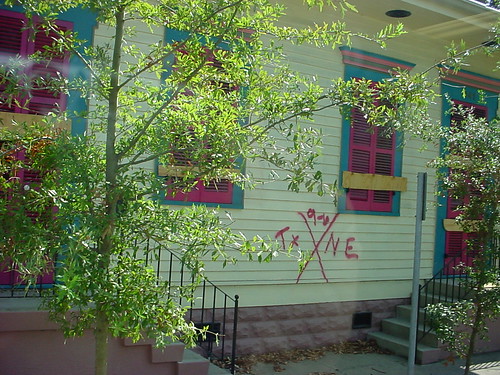
At the bottom, the number of dead found; usually that was a "0", meaning none. To see a number other than the struck through zero there always gave me a chill. The letters in the right side of the cross still remain a mystery. Sometimes they seemed to indicate a direction, as in "NE". Other times they made no sense at all. And often I'd see "TFW" written (inside a circle). I still don't know what it is. The SPCA would sometimes weigh in, as well. Their messages were easy to decipher: "K-9 moved to corner"; "1 dog alive"; "2 cats under house"; and sometimes "no dogs" or "1 dead cat".
Between these signs and messages, and the words written by the ones who had to leave in anger and bitterness, even the parts of NOLA that are still and lifeless vibrate with a thousand voices, reaching out to communicate with anyone who comes after. "Help! Help! Help!" reads the house on the street in the lower Ninth Ward. Places where not a living thing moves can make the tears come, when you read the stories that have been left there. Holes in roofs torn by the desperate, trapped inside their houses while trying to escape rising waters, still gape to remind us of their terror.
To imagine living here, constantly facing the massive deconstruction on every corner, in every yard, with your entire environment looking like one big landfill;
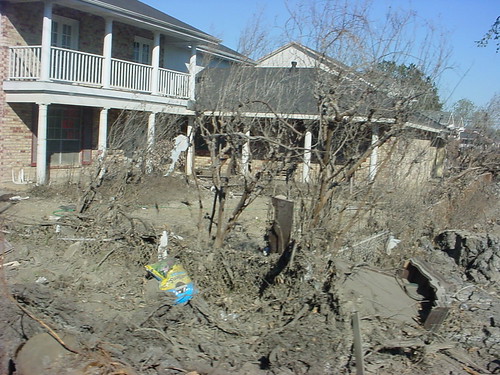
to live growing numb to the ugliness; to expect mud, cracked earth, endless dust, to always be hacking and coughing, living with low-level respiratory ailments; to wait without hope for salvation from the insurance company, the city, the federal government, to live with price gouging. To live in tents.
At home it has rained endlessly, and been cold. Here, the sun has shone everyday, and the earth is parched. Hurricane Wilma's hellacious winds sent water into the Ninth Ward again Tuesday, and what small progress made there was halted.
 I wish I could say I'll miss NOLA, or Louisiana, but I won't. It's too flat for my soul, and I miss the seasons. Fall doesn't exist here, at least in a way that makes sense to a Yankee. The few Halloween decorations I've noticed look as out of place as a Christmas tree in the middle of a bandstand on a summer night. But most of all, I won't miss the constant low-level misery, the endless fighting back against despair that is the lot of every person here. I've come to love the strength, humor, and compassion of the local people. But I don't have enough of any of those qualities to bear their miseries."
I wish I could say I'll miss NOLA, or Louisiana, but I won't. It's too flat for my soul, and I miss the seasons. Fall doesn't exist here, at least in a way that makes sense to a Yankee. The few Halloween decorations I've noticed look as out of place as a Christmas tree in the middle of a bandstand on a summer night. But most of all, I won't miss the constant low-level misery, the endless fighting back against despair that is the lot of every person here. I've come to love the strength, humor, and compassion of the local people. But I don't have enough of any of those qualities to bear their miseries."
On my day off wandering the French Quarter, one of the last people I talked to before leaving New Orleans was a small, sweet Filipino woman who ran a little souvenir shop across from the French Market. She told me how her children,ages 10 to 16, lived in Florida now because there was no place for them to stay since the storm had destroyed her house. How she was waiting and waiting and waiting for FEMA to provide her with a trailer. How the insurance company had kissed her off. How determined she was to stay on and keep trying. I told her about the Vietnamese community of Willowbrook, still deprived of power and water and being pressured to allow their land to be condemned, and the people of Lakeview, who came up to our trucks sobbing, who told us of having no income for 2 months and being made to jump through hoops by the city (set up an inspection of the property which will take half a month, then wait, then send in over $100 for the permit) in order to repair their homes. I shared with her the stories other residents had shared with me, and it made her feel less alone. We hugged and cried together.
One of the striking things about the NOLA area was the brightly colored blue tarps I had seen on roofs everywhere since I'd been down there, and shortly after my conversation with the souvenir shop owner, I learned what it was all about. A few blocks down I met an Army Corps of Engineers engineer, who had been inspecting buildings for the
FEMA Blue Roof program. As it turns out. this is nothing more than plastic sheeting installed over the damaged areas, in order to stem any further damages from the elements, until the homeowner can pay someone to fix it. If the damage is too extensive (50% or more) or makes the roof structurally unsound, it disqualifies the applicant for assistance. He told me about the Blue Roof program, and how the ACE works with FEMA on it. This is what one of their notices looks like when it goes up on a property that fails to conform to the criteria for eligibility:
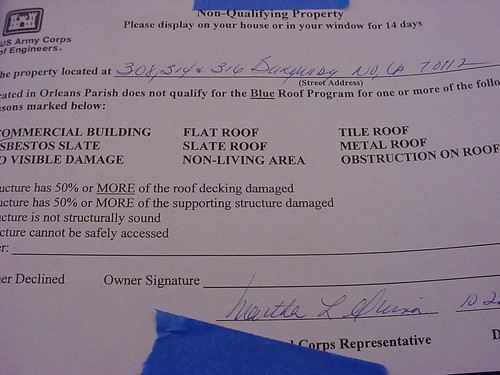
We also talked about what we had seen in the Ninth Ward, and he told me of a little old woman with problems getting around who refused to leave her house (no one was supposed to be cleared to stay there at the time). I gave him the cell phone number for one of my Red Cross supervisors so he could pass on her location. Later I learned from one of the supervisors that ERV crews had seen an old woman there rocking on her porch. I don't know what, if anything, they did.
And this is what FEMA puts up when they are trying to get in to inspect a property where the owner has requested assistance, and the owner is not at home.
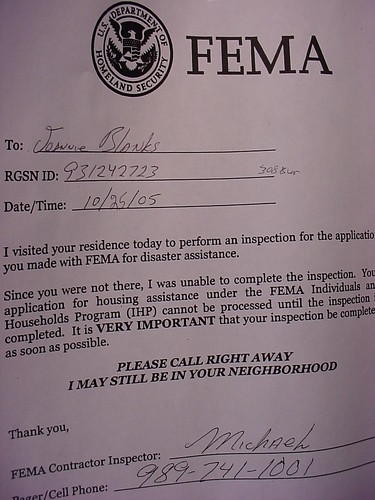
The owner may have been applying from Texas or New York, for all I know, which could account for them not being home. Whether FEMA would be aware of those circumstances would, I guess, depend on whether they are currently being run as a real agency or just a money-laundering crony employment initiative. But the condition of the house in question, which was obviously damaged and shuttered on a street with very little sign of life, might give a clue:
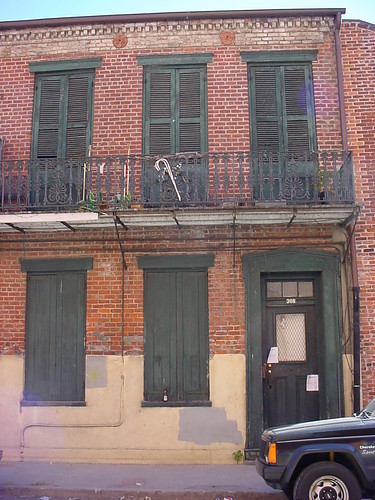
Public outrage? Not nearly enough. The majority of those affected are still reeling from massive psychological damage. Struggling just to get by from one day to the next makes it hard to think about the political and legal affronts that facilitated your misery. It takes awhile to organize behind that. People continue to suffer without power or water or transportation or easy access to food. The most common request from the people we served from the trucks was for ice. Yet for some reason people think ice is no longer an issue. Illness is rampant. Businesses are struggling to open. Jobs go begging because there is no place to live. There is no real infrastructure. Migrant workers have been shipped in to do the dangerous work of salvage, and are being forced to sleep in buses or in tents in fields. Homelessness is starting to climb again, now that the evictions have started and the vulturine landlord class has price-jacked rents. The displaced are sleeping with their children in tents while trying to find or keep jobs.
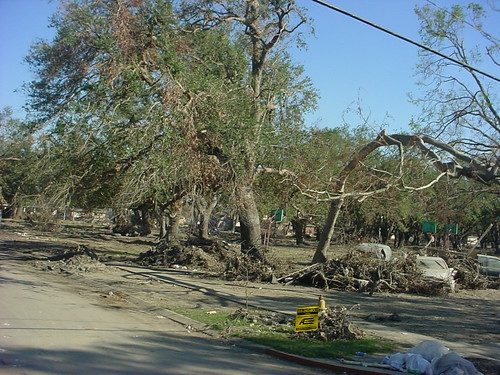
The outrage is that for some reason many people have put this unprecedented disaster behind them, and think that it will all be over in a year or two. The outrage is that Bush and his coterie of fratboys and creeps still animate the governmental corpse like a cabal of voodoo priests, and that not once since the embarrassment of the initial inconvenient slaughter has he willingly looked in on the progress being made in the Gulf Coast, or offered anything like an open hand to its ravaged victims, 5000 of whom remain missing in action. The outrage is that he still sits in the White House, and the rest of us yawn and go back to picking lint from our navels, or whatever it is that passes for quality time spent in America these days, and wait for someone else to fix everything.
(Posted at several other sites, too, because I'm sick as a dog with the New Orleans Crud and don't have the energy. Forgive me.)




 I wish I could say I'll miss NOLA, or Louisiana, but I won't. It's too flat for my soul, and I miss the seasons. Fall doesn't exist here, at least in a way that makes sense to a Yankee. The few Halloween decorations I've noticed look as out of place as a Christmas tree in the middle of a bandstand on a summer night. But most of all, I won't miss the constant low-level misery, the endless fighting back against despair that is the lot of every person here. I've come to love the strength, humor, and compassion of the local people. But I don't have enough of any of those qualities to bear their miseries."
I wish I could say I'll miss NOLA, or Louisiana, but I won't. It's too flat for my soul, and I miss the seasons. Fall doesn't exist here, at least in a way that makes sense to a Yankee. The few Halloween decorations I've noticed look as out of place as a Christmas tree in the middle of a bandstand on a summer night. But most of all, I won't miss the constant low-level misery, the endless fighting back against despair that is the lot of every person here. I've come to love the strength, humor, and compassion of the local people. But I don't have enough of any of those qualities to bear their miseries."



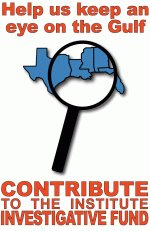


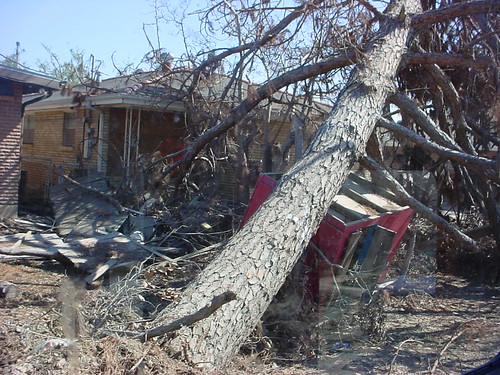
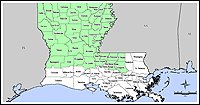 Posted at my
Posted at my 


